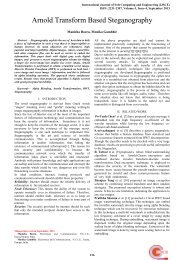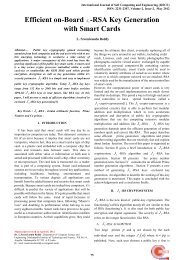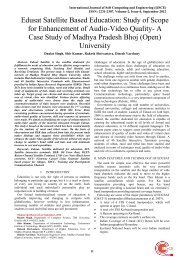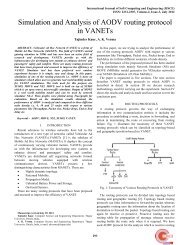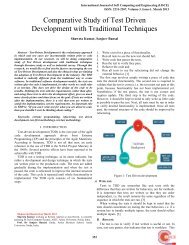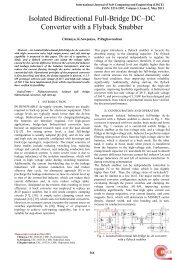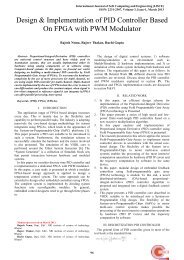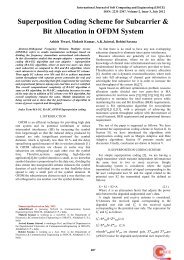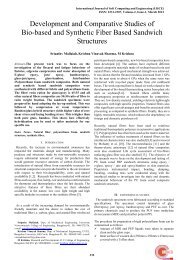Intelligent and Superior Vedic Multiplier for FPGA Based Arithmetic ...
Intelligent and Superior Vedic Multiplier for FPGA Based Arithmetic ...
Intelligent and Superior Vedic Multiplier for FPGA Based Arithmetic ...
Create successful ePaper yourself
Turn your PDF publications into a flip-book with our unique Google optimized e-Paper software.
International Journal of Soft Computing <strong>and</strong> Engineering (IJSCE)<br />
ISSN: 2231-2307, Volume-3, Issue-3, July 2013<br />
<strong>Intelligent</strong> <strong>and</strong> <strong>Superior</strong> <strong>Vedic</strong> <strong>Multiplier</strong> <strong>for</strong> <strong>FPGA</strong><br />
<strong>Based</strong> <strong>Arithmetic</strong> Circuits<br />
Virendra Babanrao Magar<br />
Abstract- The speed of a multiplier is very important to any<br />
Digital Signal Processor (DSPs). <strong>Vedic</strong> Mathematics is the<br />
earliest method of Indian mathematics which has a unique<br />
technique of calculations based on 16 Formulae. In this paper, a<br />
high per<strong>for</strong>mance, high throughput <strong>and</strong> area efficient<br />
architecture of a multiplier <strong>for</strong> the Field Programmable Gate<br />
Array (<strong>FPGA</strong>s) is proposed. This paper presents the efficiency of<br />
Urdhva Triyagbhyam <strong>Vedic</strong> method <strong>for</strong> multiplication, which<br />
strikes a difference in the actual process of multiplication itself.<br />
It enables parallel generation of partial products <strong>and</strong> eliminates<br />
unwanted multiplication steps. <strong>Multiplier</strong> architecture is based<br />
on generating all partial products <strong>and</strong> their sums in one<br />
step. Chipscope VIO is used to give r<strong>and</strong>om inputs of desired<br />
values by user, on which proposed <strong>Vedic</strong> multiplication is<br />
per<strong>for</strong>med. The proposed algorithm is modeled using VHDL i.e.<br />
Very High Speed integrated circuit hardware description<br />
language. The propagation time of the proposed architecture is<br />
found quiet less. The Xilinx Chipscope VIO generator allows us<br />
to give the runtime inputs. The Xilinx Chipscope tool will be used<br />
to test the <strong>FPGA</strong> inside results while the logic running on <strong>FPGA</strong>.<br />
The Xilinx Spartan 3 Family <strong>FPGA</strong> development board will be<br />
used <strong>for</strong> this circuit. The proposed multiplier implemented using<br />
<strong>Vedic</strong> multiplication is efficient <strong>and</strong> competent in terms of area<br />
<strong>and</strong> speed compared to its implementation using Array <strong>and</strong> Booth<br />
multiplier architectures. The results clearly indicate that Urdhava<br />
Tiryakbhyam can have a great impact on improving the speed of<br />
Digital Signal Processors.<br />
Keywords- <strong>Vedic</strong> <strong>Multiplier</strong>, urdhva tiryakbhayam, High<br />
Speed, Low Power, Latency.<br />
I. INTRODUCTION<br />
The requirement <strong>for</strong> high speed processing has been<br />
increased because of newer computer applications <strong>and</strong> to<br />
achieve the desired per<strong>for</strong>mance in many real time signal<br />
<strong>and</strong> image processing applications, higher throughput<br />
arithmetic operations are important. Instead of having more<br />
consuming processing time system, we have proposed<br />
Urdhva Triyagbhyam <strong>Vedic</strong> method <strong>for</strong> arithmetic<br />
operations which per<strong>for</strong>m a large no of mathematical<br />
calculations in a very less time. It increases the overall speed<br />
of the different electronics devices.<br />
Digital multipliers are the center components of all the<br />
digital signal processors (DSPs) <strong>and</strong> the speed of the DSP is<br />
mostly determined by the speed of its multipliers. They are<br />
necessary in the implementation of computation systems<br />
like Fast Fourier trans<strong>for</strong>ms (FFTs) <strong>and</strong> multiply accumulate<br />
(MAC). Array multiplication algorithm <strong>and</strong> Booth<br />
multiplication algorithm are most commonly multiplication<br />
algorithms implemented in the digital hardware. The<br />
computation time in array multiplier is comparatively less<br />
because it calculate execution of partial products<br />
independently by using parallelism.<br />
Manuscript received on July, 2013.<br />
Mr. Virendra B. Magar, has done AMIETE degree in Electronics &<br />
Telecommunication Engineering from Institution of Electronics &<br />
Telecommunication Engineers(IETE), New Delhi<br />
The delay associated with the array multiplier is the time<br />
taken by the signals to propagate through the gates that <strong>for</strong>m<br />
the multiplication array. Since it consume low-power <strong>and</strong><br />
have comparatively good per<strong>for</strong>mance.<br />
Booth <strong>Multiplier</strong> is another st<strong>and</strong>ard approaches <strong>and</strong><br />
multiplication algorithm to have hardware implementation<br />
of binary multiplier <strong>for</strong> VLSI implementation at low power.<br />
Large booth arrays are required <strong>for</strong> high speed<br />
multiplication <strong>and</strong> exponential operations which need huge<br />
partial sum <strong>and</strong> partial carry registers. It requires around n=<br />
(2m) clock cycles to create the least significant half of the<br />
final product <strong>for</strong> multiplication of two n-bit oper<strong>and</strong>s using a<br />
radix-4 booth recording multiplier, where m is the number<br />
of Booth recorder adder stages. Hence, a large propagation<br />
delay is associated with Booth <strong>Multiplier</strong>. Due to the<br />
importance of digital multipliers in DSP, it has always been<br />
an active area of research <strong>and</strong> a number of interesting<br />
multiplication algorithms have been reported in the<br />
literature. In this paper, we have proposed one such new<br />
multiplication algorithm which avoids the need of large<br />
multipliers by reducing the large number to the smaller<br />
number multiplication‟s count which reduces the<br />
propagation delay linked with the conventional large<br />
multipliers significantly.<br />
The structure of the proposed algorithm is based on the<br />
Urdhava Tiryakbhyam Sutra (<strong>for</strong>mula) of <strong>Vedic</strong><br />
mathematics which is simply means: “vertical <strong>and</strong> crosswise<br />
multiplication”. The procedure of multiplication using the<br />
Urdhava Tiryakbhyam involves minimum calculations,<br />
which in turn will lead to reduced number of steps in<br />
computation, reducing the space, saving more time <strong>for</strong><br />
computation. Hence it optimizes to take full advantage of<br />
reduction in the number of bits in multiplication. Although<br />
Urdhava Tiryakbhyam is applicable to all cases of<br />
multiplication, it is more efficient when the numbers<br />
involved are large.<br />
II. RELATED WORKS<br />
There have been several ef<strong>for</strong>ts <strong>for</strong> Urdhva Triyagbhyam<br />
<strong>Vedic</strong> method <strong>for</strong> multiplication. Ramesh Pushpangadan,<br />
Vineet Sukumaran has proposed methodology by using<br />
Urdhva Triyagbhyam <strong>Vedic</strong> method which having main<br />
advantages is delay increases slowly as input bit increases.<br />
V Jayaprakasan, S Vijayakumar, V S Kanchana Bhaaskaran<br />
[8] has proposed methodology of A 4x4 multiplier based on<br />
the <strong>Vedic</strong> <strong>and</strong> Conventional methods have been designed<br />
using SPICE simulator. Simulation results depict the <strong>Vedic</strong><br />
design incurring 29% of reduced average power.<br />
S<strong>and</strong>esh S. Saokar, R. M. Banakar, Saroja Siddamal [6]<br />
proposed a fast multiplier architecture <strong>for</strong> signed Q-<strong>for</strong>mat<br />
multiplications using Urdhava Tiryakbhyam method of<br />
<strong>Vedic</strong> mathematics. Since Q-<strong>for</strong>mat representation is widely<br />
used in Digital Signal Processors the proposed multiplier<br />
can substantially speed up the multiplication operation<br />
which is the basic hardware block. They occupy less area<br />
<strong>and</strong> are faster than the booth multipliers. But it has not<br />
31
<strong>Intelligent</strong> <strong>and</strong> <strong>Superior</strong> <strong>Vedic</strong> <strong>Multiplier</strong> <strong>for</strong> <strong>FPGA</strong> <strong>Based</strong> <strong>Arithmetic</strong> Circuits<br />
introduced pipeline stages in the multiplier architecture <strong>for</strong><br />
maximizing throughput.<br />
We have gone through different existing research on<br />
multiplier <strong>for</strong> less power consumption <strong>and</strong> time efficiency.<br />
But many lacunas present in this methodology. Here we<br />
have proposed our methodology which consumes less<br />
power; less area as well as less time since it optimizes the<br />
overall per<strong>for</strong>mance of the system.<br />
III. WALLACETREE MULTIPLIER<br />
In 1964, Australian Computer Scientist Chris Wallace has<br />
developed Wallace tree which is an efficient hardware<br />
implementation of a digital circuit that multiplies two<br />
integers. A fast process <strong>for</strong> multiplication of two numbers<br />
was developed by Wallace [5].<br />
Using this method, a three step process is used to multiply<br />
two numbers; the bit products are <strong>for</strong>med, the bit product<br />
matrix is reduced to a two row matrix where sum of the row<br />
equals the sum of bit products, <strong>and</strong> the two resulting rows<br />
are summed with a fast adder to produce a final product.<br />
Three bit signals are passed to a one bit full adder<br />
(“3W”) which is called a three input Wallace tree circuit <strong>and</strong><br />
the output of sum signal is supplied to the next stage full<br />
adder of the same bit. The carry output signal is passed to<br />
the next stage full adder of the same no of bit, <strong>and</strong> the carry<br />
output signal thereof is supplied to the next stage of the full<br />
adder located at a one bit higher position.<br />
Wallace tree is a tree of carry-save adders (CSA) arranged<br />
as shown in figure 1. A carry save adder consists of full<br />
adders like the more familiar ripple adders, but the carry<br />
output from each bit is brought out to <strong>for</strong>m second result<br />
vector rather being than wired to the next most significant<br />
bit.<br />
Fig 1: Wallace tree of carry-save adders<br />
The carry vector is 'saved' to be combined with the sum<br />
later. In the Wallace tree method, the circuit layout is not<br />
easy although the speed of the operation is high since the<br />
circuit is quite irregular.<br />
Wallace tree is known <strong>for</strong> their optimal computation time,<br />
when adding multiple oper<strong>and</strong>s to two outputs using carrysave<br />
adders. The Wallace tree guarantees the lowest overall<br />
delay but requires the largest number of wiring tracks. The<br />
number of wiring tracks is a measure of wiring complexity.<br />
IV. BOOTH MULTIPLIER<br />
Another improvement in the multiplier is by reducing the<br />
number of partial products generated. Booth's multiplication<br />
algorithm is a multiplication algorithm that multiplies two<br />
signed binary numbers in two's complement notation. The<br />
algorithm was invented by Andrew Donald Booth in<br />
1950[4].<br />
The Booth recording multiplier is such multiplier which<br />
scans the three bits at a time to reduce the number of partial<br />
products. These three bits are: the two bit from the present<br />
pair; <strong>and</strong> a third bit from the high order bit of an adjacent<br />
lower order pair. After examining each triplet of bits, the<br />
triplets are converted by Booth logic into a set of five<br />
control signals used by the adder cells in the array to control<br />
the operations per<strong>for</strong>med by the adder cells.<br />
To speed up the multiplication Booth encoding per<strong>for</strong>ms<br />
several steps of multiplication at once. Booth‟s algorithm<br />
takes advantage of the fact that an adder, sub tractor is<br />
nearly as fast <strong>and</strong> small as a simple adder. If 3 consecutive<br />
bits are same then addition/subtraction operation can be<br />
skipped.<br />
Thus in most of the cases the delay associated with Booth<br />
Multiplication are smaller than that with Array <strong>Multiplier</strong>.<br />
However the per<strong>for</strong>mance of Booth <strong>Multiplier</strong> <strong>for</strong> delay is<br />
input data dependant. In the worst case the delay with booth<br />
multiplier is on par with Array <strong>Multiplier</strong>. The method of<br />
Booth recording reduces the numbers of adders <strong>and</strong> hence<br />
the delay required to produce the partial sums by examining<br />
three bits at a time.<br />
The high per<strong>for</strong>mance of booth multiplier comes with the<br />
drawback of power consumption. The reason is large<br />
number of adder cells required that consumes large power.<br />
V. VEDIC MATHEMATICS<br />
<strong>Vedic</strong> Mathematics hails from the ancient Indian scriptures<br />
called “Vedas” or the source of knowledge. This system of<br />
computation covers all <strong>for</strong>ms of mathematics, be it<br />
geometry, trigonometry or algebra. The prominent feature of<br />
<strong>Vedic</strong> Mathematics is the rationality in its algorithms which<br />
are designed to work naturally. This makes it the easiest <strong>and</strong><br />
fastest way to per<strong>for</strong>m any mathematical calculation<br />
mentally.<br />
<strong>Vedic</strong> Mathematics is believed to be created around 1500<br />
BC <strong>and</strong> was rediscovered between 1911 to 1918 by Sri<br />
Bharti Krishna Tirthaji (1884-1960) who was a Sanskrit<br />
scholar, mathematician <strong>and</strong> a philosopher [1].<br />
He organized <strong>and</strong> classified the whole of <strong>Vedic</strong><br />
Mathematics into 16 <strong>for</strong>mulae or also called as sutras. These<br />
<strong>for</strong>mulae <strong>for</strong>m the backbone of <strong>Vedic</strong> mathematics. Great<br />
amount of research has been done all these years to<br />
implement algorithms of <strong>Vedic</strong> mathematics on digital<br />
processors.<br />
It has been observed that due to coherence <strong>and</strong> symmetry in<br />
these algorithms it can have a regular silicon layout <strong>and</strong><br />
consume less area along with lower power consumption.<br />
VI. URDHAVA TIRYAKBHYAM METHOD<br />
Urdhava Tiryakbhyam [2] is a Sanskrit word which means<br />
vertically <strong>and</strong> crosswire in English. The method is a general<br />
multiplication <strong>for</strong>mula applicable to all cases of<br />
multiplication. It is based on a novel concept through which<br />
all partial products are generated concurrently.<br />
Fig. 2 demonstrates a 4x4 binary multiplication using this<br />
method. The method can be generalized <strong>for</strong> any N x N bit<br />
multiplication. This type of multiplier is independent of the<br />
clock frequency of the processor because the partial<br />
products <strong>and</strong> their sums are calculated in parallel. The net<br />
advantage is that it reduces the need of microprocessors to<br />
32
operate at increasingly higher clock frequencies. As the<br />
operating frequency of a processor increases the number of<br />
switching instances also increases. This results in more<br />
power consumption <strong>and</strong> also dissipation in the <strong>for</strong>m of heat<br />
which results in higher device operating temperatures.<br />
Another advantage of Urdhva Tiryakbhyam multiplier is its<br />
scalability. The processing power can easily be increased by<br />
increasing the input <strong>and</strong> output data bus widths since it has a<br />
regular structure. Due to its regular structure, it can be easily<br />
layout in a silicon chip <strong>and</strong> also consumes optimum area. As<br />
the number of input bits increase, gate delay <strong>and</strong> area<br />
increase very slowly as compared to other multipliers.<br />
There<strong>for</strong>e Urdhava Tiryakbhyam multiplier is time, space<br />
<strong>and</strong> power efficient. The line diagram in fig. 2 illustrates the<br />
algorithm <strong>for</strong> multiplying two 4-bit binary numbers<br />
a3a2a1a0 <strong>and</strong> b3b2b1b0. The procedure is divided into 7<br />
steps <strong>and</strong> each step generates partial products.<br />
Initially as shown in step 1 of fig. 2, the least significant bit<br />
(LSB) of the multiplier is multiplied with least significant<br />
bit of the multiplic<strong>and</strong> (vertical multiplication). This result<br />
<strong>for</strong>ms the LSB of the product. In step 2 next higher bit of the<br />
multiplier is multiplied with the LSB of the multiplic<strong>and</strong> <strong>and</strong><br />
the LSB of the multiplier is multiplied with the next higher<br />
bit of the multiplic<strong>and</strong> (crosswire multiplication). These two<br />
partial products are added <strong>and</strong> the LSB of the sum is the<br />
next higher bit of the final product <strong>and</strong> the remaining bits<br />
are carried to the next step.<br />
For example, if in some intermediate step, we get the result<br />
as 1101, then 1 will act as the result<br />
Step 1 Step 2 Step3 Step4<br />
0000 0000 0000 0000<br />
0000 0000 0000 0000<br />
Step 5 Step6 Step7<br />
0000 0000 0000<br />
0000 0000 0000<br />
Fig. 2 Line diagram showing multiplication of two 4 bit<br />
numbers using Urdhava Tiryakbhyam method<br />
Bit (referred as rn) <strong>and</strong> 110 as the carry (referred as cn).<br />
There<strong>for</strong>e c n may be a multi-bit number. Similarly other<br />
steps are carried out as indicated by the line diagram. The<br />
important feature is that all the partial products <strong>and</strong> their<br />
sums <strong>for</strong> every step can be calculated in parallel.<br />
International Journal of Soft Computing <strong>and</strong> Engineering (IJSCE)<br />
ISSN: 2231-2307, Volume-3, Issue-3, July 2013<br />
For inputs a3 a2 a1 a0 <strong>and</strong> b3 b2 b1 b0:<br />
P0=a 0 b 0<br />
C0P1=a 0 b 1 +a 1 b 0<br />
C1P2=C0+a 0 b 2 +a 2 b 0 +a 1 b 1<br />
C2P3=C1+a 3 b 0 +a 0 b 3 +a 1 b 2 +a 2 b 1 +C 00<br />
C3P4=C2+a 3 b 1 +a 1 b 3 +a 2 b 2 +C 01 +C 10<br />
C4P5=C3+a 3 b 2 +a 2 b 3 +C 11 +C 20<br />
C5P6=C4+a 3 b 3 +C 21<br />
The 8x8 vedic multiplier module is implemented using four<br />
4x4 vedic multiplier modules of fig.3 as shown in fig.4.<br />
Here partial product generation <strong>and</strong> addition is done<br />
concurrently. b7b6b5b4b3b2b1b0 <strong>and</strong> a7a6a5a4a3a2a1a0<br />
are taken as two binary numbers. 4x4 vedic multiplier<br />
modules, three 8 bit ripple carry adder are used to generate<br />
the desired 16 bit product s15 down to s0. The least<br />
significant 4 bits of the result of rightmost 4x4 vedic<br />
multiplier produce the result s3s2s1s0. The 8 bit ripple carry<br />
adder(located in middle in fig.4.) adds two 8 bits oper<strong>and</strong>s<br />
i.e concatenated 8 bits (“0000” <strong>and</strong> most The upper 8 bit<br />
ripple carry adder adds the results of two 4x4 vedic<br />
multiplier modules(second <strong>and</strong> third from right) <strong>and</strong><br />
generates one carry <strong>and</strong> 8 bit result. The bottom 8 bit ripple<br />
carry adder adds 4x4 vedic multiplier module result <strong>and</strong><br />
concatenated 8 bits (“000”, carry from upper 8 bit ripple<br />
carry adder <strong>and</strong> most significant bits of the result from<br />
middle 8 bit ripple carry adder) to generate the most<br />
significant bits of the final product i.e.<br />
s15s14s13s12s11s10s9s8. Significant four bits of rightmost<br />
4x4 vedic. It generates the resultant bits s7s6s5s4 at its<br />
output. multiplier module) <strong>and</strong> the result of second from<br />
right 4x4 vedic multiplier module.<br />
VII. HE MULTIPLIER ARCHITECTURE<br />
Fig.3. 4X4 <strong>Vedic</strong> multiplier structure<br />
Fig4: Block Diagram of 8*8 bit <strong>Vedic</strong> <strong>Multiplier</strong>.<br />
VIII. <strong>FPGA</strong> ARCHITECTURE<br />
Field-Programmable Gate Arrays (<strong>FPGA</strong>s) have become<br />
one of the key digital circuit implementation media over the<br />
last decade. A crucial part of their creation lies in their<br />
architecture, which governs the nature of their<br />
programmable logic functionality <strong>and</strong> their programmable<br />
inter-connect. <strong>FPGA</strong> architecture has a dramatic effect on<br />
the quality of the final device‟s speed per<strong>for</strong>mance, area<br />
efficiency, <strong>and</strong> power consumption. Field-Programmable<br />
Gate Arrays (<strong>FPGA</strong>s) are pre-fabricated silicon devices that<br />
can be electrically programmed to become almost any kind<br />
of digital circuit or system.<br />
<strong>FPGA</strong>‟s, consist of an array of programmable logic blocks<br />
of Potentially different types, including general logic,<br />
memory <strong>and</strong> multiplier blocks, surrounded by a<br />
33
<strong>Intelligent</strong> <strong>and</strong> <strong>Superior</strong> <strong>Vedic</strong> <strong>Multiplier</strong> <strong>for</strong> <strong>FPGA</strong> <strong>Based</strong> <strong>Arithmetic</strong> Circuits<br />
programmable routing fabric that allows blocks to be<br />
programmable interconnected.<br />
The array is surrounded by programmable input/output<br />
blocks. The “programmable” term in <strong>FPGA</strong> indicates an<br />
ability to program a function into the chip after silicon<br />
fabrication is complete.<br />
This customization is made possible by the programming<br />
technology, which is a method that can cause a change in<br />
the behavior of the pre-fabricated chip after fabrication, in<br />
the “field,” where system users create designs,<br />
A) Simulation Results<br />
IX. EXPERIMENTAL RESULTS<br />
Fig. 5. Simulation result <strong>for</strong> 8 bit vedic multiplier using <strong>Vedic</strong> Mathematics<br />
B) Technology View<br />
Fig.6. Technology view of 8 bit multiplier using <strong>Vedic</strong> Mathematics<br />
C) Chipscope Results<br />
Here two 8- bit numbers are given to our vedic multiplier.<br />
The intermediate results from the 8-bit ripple carry adders,<br />
4X4 vedic multiplier are used <strong>and</strong> we can observe the<br />
outputs of <strong>Vedic</strong> multiplier <strong>for</strong> variable length inputs by<br />
using Chipscope-VIO. These results <strong>for</strong> various inputs are<br />
verified using normal calculator.Data inputs given to vedic<br />
multiplier using Chipscope-VIO are as follows;<br />
34
International Journal of Soft Computing <strong>and</strong> Engineering (IJSCE)<br />
ISSN: 2231-2307, Volume-3, Issue-3, July 2013<br />
Fig. 7. Data inputs given to vedic multiplier using Chipscope<br />
‣ Here we are giving the variable length inputs in runtime using Chipscope-VIO<br />
‣ We can give desired inputs to <strong>Vedic</strong> multiplier at runtime are shown above.<br />
Fig.8. Data output of vedic multiplier with inputs.<br />
The corresponding results <strong>for</strong> various inputs we can obtain<br />
in Chipscope analyser are shown above. The results<br />
obtained <strong>for</strong> various test patterns are verified using normal<br />
calculator.<br />
X. CONCLUSION<br />
It can be concluded that <strong>Vedic</strong> multiplier <strong>and</strong> square is faster<br />
than array multiplier <strong>and</strong> Booth multiplier. The arrangement<br />
of adders at architectural level is the main focus of this<br />
work. The difference of the adder count is the importance<br />
source which reduces the average power of the <strong>Vedic</strong><br />
multiplier. Due to factors of timing efficiency, speed <strong>and</strong><br />
lesser area, the proposed <strong>Vedic</strong> multiplier <strong>and</strong> square can be<br />
implemented in <strong>Arithmetic</strong> <strong>and</strong> Logical Units replacing the<br />
traditional multipliers <strong>and</strong> squares based on array <strong>and</strong> Booth<br />
multiplication.<br />
In summary, embodiments of the invention provide a design<br />
<strong>for</strong> a flexible multiplier <strong>and</strong> square which can be<br />
considerably faster than existing multipliers <strong>and</strong> squares<br />
reported previously in the literature. The speed<br />
improvements are gained by parallelizing the generation of<br />
partial products with their concurrent summations. It is<br />
demonstrated that this design is quite efficient in terms of<br />
silicon area/speed. Such a design should enable substantial<br />
savings of resources in the <strong>FPGA</strong> when used <strong>for</strong><br />
image/video processing applications. The combination path<br />
delay found is 20.499ns with speed grade -5. The Urdhava<br />
Tiryakbhyam Q-<strong>for</strong>mat multiplier is best suited <strong>for</strong> signal<br />
processing applications requiring faster multiplications.<br />
ACKNOWLEDGEMENT<br />
I am very thankful to the people those who have provided<br />
me continuous encouragement <strong>and</strong> support to all the stages<br />
<strong>and</strong> ideas visualize. I am very much grateful to the entire<br />
Lord Krishna College of Technology, Indore‟s group <strong>for</strong><br />
giving me all facilities <strong>and</strong> work environment which enable<br />
me to complete my task. I am also thankful to all researchers<br />
which I have mentioned in reference list <strong>and</strong> I am sorry if I<br />
<strong>for</strong>get to mention name of anybody here as well as in<br />
reference list.<br />
35
<strong>Intelligent</strong> <strong>and</strong> <strong>Superior</strong> <strong>Vedic</strong> <strong>Multiplier</strong> <strong>for</strong> <strong>FPGA</strong> <strong>Based</strong> <strong>Arithmetic</strong> Circuits<br />
REFERENCE<br />
[1] Jagadguru Swami Sri Bharati Krisna Tirthaji Maharaja, “<strong>Vedic</strong><br />
Mathematics: Sixteen Simple Mathematical Formulae from the<br />
Veda,” Motilal Banarasidas Publishers, Delhi, 2009, pp. 5-45.<br />
[2] H. Thapliyal <strong>and</strong> M. B. Shrinivas <strong>and</strong> H. Arbania, “Design <strong>and</strong><br />
Analysis of a VLSI <strong>Based</strong> High Per<strong>for</strong>mance Low Power Parallel<br />
Square Architecture,” Int. Conf. Algo.Math.Comp. Sc., Las Vegas,<br />
June 2005, pp. 72-76.<br />
[3] „Xilinx ISE User manual‟, Xilinx Inc, USA, 2007<br />
[4] A. D. Booth, “A signed binary multiplication technique,” Q. J.<br />
Mech.Appl. Math., vol. 4, pp. 236–240, 1951.<br />
[5] C. S. Wallace, "A suggestion <strong>for</strong> a fast multiplier," lEEE<br />
Trans.Electronic Comput., vol. EC-\3, pp. 14-17, Dec. 1964.<br />
[6] S<strong>and</strong>esh S. Saokar, R. M. Banakar, Saroja Siddamal, “High Speed<br />
Signed <strong>Multiplier</strong> <strong>for</strong> Digital Signal Processing Applications” 2012<br />
IEEE.<br />
[7] A.Raman, A.Kumar <strong>and</strong> R.K.Sarin, “High Speed Reconfigurable<br />
FFT Design by <strong>Vedic</strong> Mathematics”, Journal of Computer Science<br />
<strong>and</strong> Engineering, Vol. 1, Issue 1, pp 59-63, May,2010.<br />
[8] V Jayaprakasan, S Vijayakumar, V S Kanchana Bhaaskaran,<br />
“Evaluation of the Conventional vs. Ancient Computation<br />
methodology <strong>for</strong> Energy Efficient <strong>Arithmetic</strong> Architecture”.<br />
[9] R. Pushpangadan, V. Sukumaran, R.Innocent, D.Sasikumar, <strong>and</strong><br />
V.Sunder, “High Speed <strong>Vedic</strong> <strong>Multiplier</strong> <strong>for</strong> Digital Signal<br />
Processors”, IETE Journal of Research, vol.55, pp.282-286, 2009.<br />
Mr. Virendra B. Magar, has done AMIETE degree in<br />
Electronics & Telecommunication Engineering from<br />
Institution of Electronics & Telecommunication<br />
Engineers(IETE), New Delhi in 2008 <strong>and</strong> persuing<br />
M.Tech degree in VLSI from Lord Krishna College<br />
of Technology, Indore, under Rajiv G<strong>and</strong>hi<br />
Proudyogoki Vishwavidyalaya, Bhopal, India.<br />
Current he is doing his research in low power VLSI<br />
design.<br />
36



